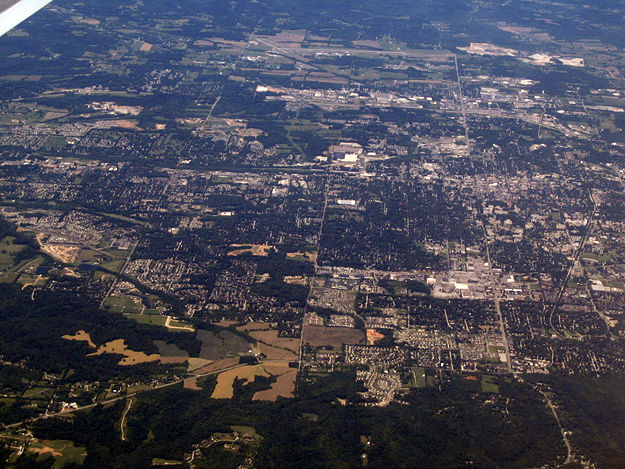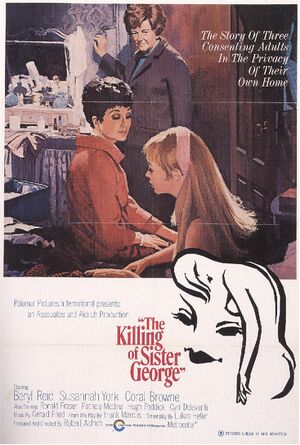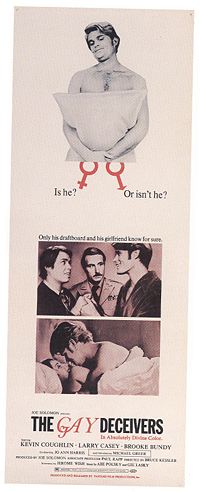Difference between revisions of "The Midwest's "Queer Mecca": 40 Years of GLBTQ History in Bloomington, Indiana (1969-2009)"
m (Protected "The Midwest's "Queer Mecca": 40 Years of GLBTQ History in Bloomington, Indiana (1969-2009)" [edit=sysop:move=sysop]) |
|||
| (13 intermediate revisions by one other user not shown) | |||
| Line 1: | Line 1: | ||
| − | + | [[Image:Bloomington.JPG|thumb|625px|An aerial view of Bloomington. The Indiana University campus and the downtown area are in the middle right of the picture.]] | |
| − | |||
| − | + | ---- | |
| − | |||
| + | As late Friday night rolled over into the early morning hours of Saturday, June 28, 1969, nothing in Bloomington, Indiana[[Image:sistergeorge.jpg|thumb|left]] would suggest that a riot was breaking out 675 miles away in New York City. | ||
| − | --- | + | The rioting that began in the aftermath of a police raid at the Stonewall Inn, on Christopher Street in the Greenwich Village neighborhood of Manhattan, has been commemorated ever since as the “beginning of the gay rights movement” in the United States. Turning the story of Stonewall into a paradigm, however, and assuming that LGBT culture originated in coastal cities and migrated from there into the heartland, doesn’t do justice to the complexity of local LGBT life in rural and non-metropolitan locations, both before and after Stonewall. |
| + | |||
| + | Drag queens weren’t rioting in downtown Bloomington in the summer of ’69, but a few short blocks off that small city’s town square, with its Capra-esque [[Image:Gaydeceivers.jpg|thumb|200px]]courthouse and public library, the Towne Cinema was screening ''The Killing of Sister George'', a film about an intergenerational butch-femme lesbian relationship, as well as ''The Gay Deceivers'', a film about two men who pretend to be gay to avoid the draft. | ||
| + | |||
| + | LGBT people in Bloomington hadn't begun protesting their discrimination at the hands of the police or the business community, forming activist organizations, writing impassioned speeches about gay liberation, or arguing in feminist coffeehouses about the politics of lesbianism—at least not yet—but the signs of a distinctive Hoosier queerness were there to be seen, like those two movies at the Towne Cinema, by those with the eyes to see them. | ||
| + | ---- | ||
:[[PROJECT OVERVIEW]] | :[[PROJECT OVERVIEW]] | ||
| Line 25: | Line 29: | ||
:[[APPENDIX: ANNOTATED CHRONOLOGY, 1969-2009]] | :[[APPENDIX: ANNOTATED CHRONOLOGY, 1969-2009]] | ||
| + | :[[APPENDIX: PROFILES, ORAL HISTORIES, AND INTERVIEWS]] | ||
| + | |||
| + | :[[PHOTO GALLERY]] | ||
| + | |||
| + | :[[ADDITIONAL RESOURCES]] | ||
---- | ---- | ||
| Line 30: | Line 39: | ||
| − | === | + | ===A Message to Our Visitors:=== |
| − | This preliminary history of LGBT Bloomington was begun by students at Indiana University, specifically for the purpose of entering OutHistory.org’s “Since Stonewall” local LGBT history contest. And yet, our larger goal has never been to produce a "one-off" online exhibit, but rather to lay the foundation for an on-going exploration of our community's history. Our project thus necessarily remains incomplete--in concrete details that will be finished at some not too distant | + | This preliminary history of LGBT Bloomington was begun by students at Indiana University, specifically for the purpose of entering OutHistory.org’s “Since Stonewall” local LGBT history contest. And yet, our larger goal has never been to produce a "one-off" online exhibit, but rather to lay the foundation for an on-going exploration of our community's history. Our project thus necessarily remains incomplete--in concrete details that will be finished at some point in the not too distant future, as well as in a more open-ended and philosophical sense. |
Many individual exhibit pages that have been researched have not yet been uploaded; many illustrative images have yet to be incorporated into the individual pages; oral histories that have been conducted have not yet been transcribed; some entries are lacking citations, and some citations are not in proper form. Even so, the contours of Bloomington's LGBT history are already coming into clearer focus. And this, for us, has been our primary accomplishment--we have surveyed a historical landscape that has never before been mapped in any kind of comprehensive fashion. | Many individual exhibit pages that have been researched have not yet been uploaded; many illustrative images have yet to be incorporated into the individual pages; oral histories that have been conducted have not yet been transcribed; some entries are lacking citations, and some citations are not in proper form. Even so, the contours of Bloomington's LGBT history are already coming into clearer focus. And this, for us, has been our primary accomplishment--we have surveyed a historical landscape that has never before been mapped in any kind of comprehensive fashion. | ||
| Line 41: | Line 50: | ||
| − | + | ||
| + | ===Acknowledgements=== | ||
This project began in Fall Semester 2009 as a class project in Professor Susan Stryker’s “G206: Gay History, Queer Culture,” a regularly offered lower-division course in the Gender Studies Department at Indiana University. A great deal more work was completed as an independent study project in Spring Semester 2010 by Evelyn Smith and Chris Kase, two especially talented students who were particularly enthusiastic about continuing to conduct research. Antonia Leotsakos made many additional valuable contributions while working as a research assistant to Dr. Stryker. | This project began in Fall Semester 2009 as a class project in Professor Susan Stryker’s “G206: Gay History, Queer Culture,” a regularly offered lower-division course in the Gender Studies Department at Indiana University. A great deal more work was completed as an independent study project in Spring Semester 2010 by Evelyn Smith and Chris Kase, two especially talented students who were particularly enthusiastic about continuing to conduct research. Antonia Leotsakos made many additional valuable contributions while working as a research assistant to Dr. Stryker. | ||
| Line 61: | Line 71: | ||
| − | [[Category:Stryker]] | + | ===Contact=== |
| + | If you have corrections, additions, or other feedback, please contact Susan Stryker: stryksus@indiana.edu | ||
| + | |||
| + | [[Category:Stryker]] <comments /> | ||
Latest revision as of 11:26, 1 May 2010
As late Friday night rolled over into the early morning hours of Saturday, June 28, 1969, nothing in Bloomington, Indiana
would suggest that a riot was breaking out 675 miles away in New York City.
The rioting that began in the aftermath of a police raid at the Stonewall Inn, on Christopher Street in the Greenwich Village neighborhood of Manhattan, has been commemorated ever since as the “beginning of the gay rights movement” in the United States. Turning the story of Stonewall into a paradigm, however, and assuming that LGBT culture originated in coastal cities and migrated from there into the heartland, doesn’t do justice to the complexity of local LGBT life in rural and non-metropolitan locations, both before and after Stonewall.
Drag queens weren’t rioting in downtown Bloomington in the summer of ’69, but a few short blocks off that small city’s town square, with its Capra-esque
courthouse and public library, the Towne Cinema was screening The Killing of Sister George, a film about an intergenerational butch-femme lesbian relationship, as well as The Gay Deceivers, a film about two men who pretend to be gay to avoid the draft.
LGBT people in Bloomington hadn't begun protesting their discrimination at the hands of the police or the business community, forming activist organizations, writing impassioned speeches about gay liberation, or arguing in feminist coffeehouses about the politics of lesbianism—at least not yet—but the signs of a distinctive Hoosier queerness were there to be seen, like those two movies at the Towne Cinema, by those with the eyes to see them.
A Message to Our Visitors:
This preliminary history of LGBT Bloomington was begun by students at Indiana University, specifically for the purpose of entering OutHistory.org’s “Since Stonewall” local LGBT history contest. And yet, our larger goal has never been to produce a "one-off" online exhibit, but rather to lay the foundation for an on-going exploration of our community's history. Our project thus necessarily remains incomplete--in concrete details that will be finished at some point in the not too distant future, as well as in a more open-ended and philosophical sense.
Many individual exhibit pages that have been researched have not yet been uploaded; many illustrative images have yet to be incorporated into the individual pages; oral histories that have been conducted have not yet been transcribed; some entries are lacking citations, and some citations are not in proper form. Even so, the contours of Bloomington's LGBT history are already coming into clearer focus. And this, for us, has been our primary accomplishment--we have surveyed a historical landscape that has never before been mapped in any kind of comprehensive fashion.
Uploading the backlog of completed research, refining the prose, and fine-tuning of the site's form and scholarly apparatus, will all continue to develop beyond the closing date of the "Since Stonewall" local history competition. The platform established here is intended as a solicitation for ongoing work, which will result in an increasingly robust site as time goes by. The detailed chronology of LGBT-related events, pulled together for the first time from an exhaustive survey of newspaper sources, is in itself a vital baseline resource for any future research.
We hope that you find the first fruits of our labor appealing, and are inspired to continue the on-going work of documenting Bloomington's queer history!
Acknowledgements
This project began in Fall Semester 2009 as a class project in Professor Susan Stryker’s “G206: Gay History, Queer Culture,” a regularly offered lower-division course in the Gender Studies Department at Indiana University. A great deal more work was completed as an independent study project in Spring Semester 2010 by Evelyn Smith and Chris Kase, two especially talented students who were particularly enthusiastic about continuing to conduct research. Antonia Leotsakos made many additional valuable contributions while working as a research assistant to Dr. Stryker.
Students in G206 who contributed to this research include: James Armstrong, Valerie Biondi, Erin Brady, James Conrad, Douglas Cooper, Anna Dykema, Scott Eberhard, Erin Engledow, Miranda Ettinger, Joshua Field, Alyssa Goldman, Bryn Hannon, Jurion Jaffe, Tara Johnson, Danielle Jonas, Jessica Lajoie, Lindsay Lauver, Allyson Lodics, Jeff McInnes, Brenna Moeljadi, Sarah Pennal, Alexandra Riley, Katherine Roberson, Jordan Schmid, Benjamin Siebert, Geoffrey Sperling, Dylan Swift, Sarah Taylor, Julia Turner, and Tay’ler Wells.
Doug Bauder, Carol Fischer and Solomon Hursey of IU’s GLBT Student Support Services Office all gave generously of their time—Solomon made available many important historical documents that he had scanned from the office files, as well as a fragment of his own spatial analysis of pre-Stonewall gay Bloomington, based on anonymous interviews with older gay men; Carol facilitated contact between longtime Bloomington LGBT community members and class members who wanted to conduct oral interviews with them, and Doug graciously agreed to be interviewed. Other interviewees included Robert Brookshire, Jean Capler, Helen Harrell, Victor Kinzer, Doug McKinney, Duncan Mitchell, George Pinney, Monte Simonton Jr., Katherine Brown Sterritte, Cynthia Stone, Martha Vicinus, Carolyn Marie Weithoff, and Linda Giovanna Zambanini.
Many information sciences professionals helped us get as far as we have: our deep appreciation goes to Dina Kellams, Carrie Lynn Schweir, and Bradley Cook of Indiana University Archives; to Lou Malcomb of Herman B Wells Library Government Information; to Shawn Wilson, Jennifer Bass, and Catherine Johnson-Rohr of the Kinsey Institute; to Michael Maben and Peter Hook of Indiana University Mauer School of Law Library; to Steve Backs and Christine Eykolt Friesel of the Indiana Room of the Monroe County Public Library; to Barbara McKinney of the City of Bloomington Legal Department; and to Regina Moore and Barbara Heather of the Bloomington City Clerk's Office. Thank you all for your knowledge of local history sources and your willingness to engage with student in their research.
Professors Colin Johnson and Mary Gray both shared their wisdom about rural queer culture--thank you both, for your specific help as well as for your inspiring commitment to making IU a place to study queer rurality.
And special thanks to Rachael, of Rachael’s Café, whose upbeat attitude and mad barista skills on the espresso pull kept us buzzin'!
Contact
If you have corrections, additions, or other feedback, please contact Susan Stryker: stryksus@indiana.edu <comments />


